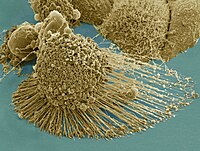
Photo from wikipedia
Background Radiation-induced late effects are a common cause of morbidity among cancer survivors. The biomarker with the best evidence as a predictive test of late reactions is the radiation-induced lymphocyte… Click to show full abstract
Background Radiation-induced late effects are a common cause of morbidity among cancer survivors. The biomarker with the best evidence as a predictive test of late reactions is the radiation-induced lymphocyte apoptosis (RILA) assay. We aimed to investigate the molecular basis underlying the distinctive RILA levels by using gene expression analysis in patients with and without late effects and in whom we had also first identified differences in RILA levels. Patients and Methods Peripheral blood mononuclear cells of 10 patients with late severe skin complications and 10 patients without symptoms, selected from those receiving radiotherapy from 1993 to 2007, were mock-irradiated or irradiated with 8 Gy. The 48-h response was analyzed in parallel by RILA assay and gene expression profiling with Affymetrix microarrays. Irradiated and non-irradiated gene expression profiles were compared between both groups. Gene set enrichment analysis was performed to identify differentially expressed biological processes. Results Although differentially expressed mRNAs did not reach a significant adjusted p-value between patients suffering and not suffering clinical toxicity, the enriched pathways indicated significant differences between the two groups, either in irradiated or non-irradiated cells. In basal conditions, the main differentially expressed pathways between the toxicity and non-toxicity groups were the transport of small molecules, interferon signaling, and transcription. After 8 Gy, the differences lay in pathways highly related to cell senescence like cell cycle/NF-κB, G-protein-coupled receptors, and interferon signaling. Conclusion Patients at risk of developing late toxicity have a distinctive pathway signature driven by deregulation of immune and cell cycle pathways related to senescence, which in turn may underlie their low RILA phenotype.
Journal Title: Frontiers in Oncology
Year Published: 2022
Link to full text (if available)
Share on Social Media: Sign Up to like & get
recommendations!